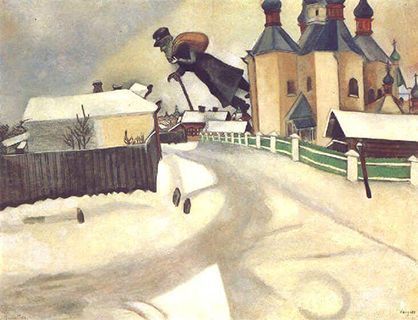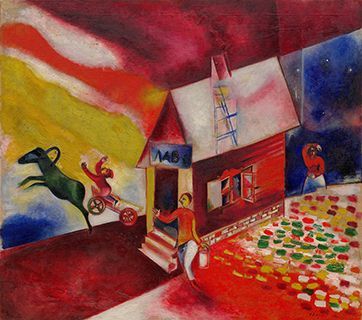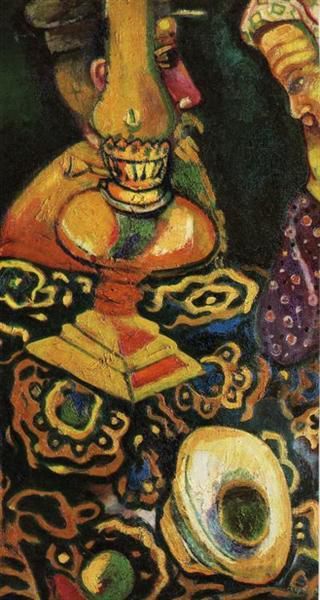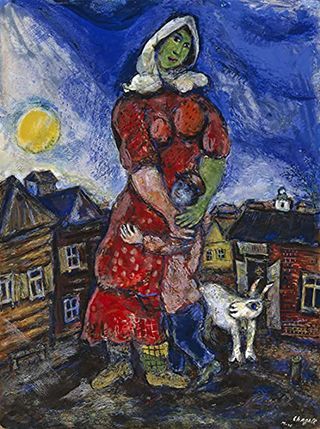A Sense of Place: Part Two - Through the Eyes and Mind of Marc Chagall
Marc Chagall (1887-1985) was born in the little house near the Pestkowatik Road in Vitebsk a photo of which I showed you yesterday. Chagall said that the cottage: reminds me of the bump on the head of the rabbi in green I painted, or of a potato tossed into a barrel of herring and soaked in pickling brine.
But after a few years his father bought another house in Vitebsk where Chagall grew up with the hens strutting on the rough flagstone in the yard; the cats promenading on the roofs; and the craftsmen laboring in the mean houses. From the attic one could discover a whole empire of houses, fences, hills, little churches - all Chagall's Vitebsk as we know it from so many of his pictures. And the stars above - "My sweet stars; they accompany me to school and wait for me on the street till I return." 1
Chagall's closeness to his ancestoral roots exemplifying his sense of place is embedded in most of his works but let's start today by taking a closer look at Over Vitebsk.

Over Vitebsk belongs to a large series of works that the artist began after his return to his hometown in June 1914, which take as their subject an over-life-size, elderly beggar floating above the snow-laden rooftops of Vitebsk. The painting plays on the Yiddish expression for a beggar moving from door to door, "er geyt iber di hayzer", which translates as "he walks over the houses." This whimsical turn of phrase allowed Chagall to transform an otherwise naturalistically rendered scene of Vitebsk in winter through the addition of a strange airborne character with a sack on his back, whose presence imbues the composition with a dreamlike otherworldliness (marcchagall.net)
Looking at Over Vitebsk (above) or The Flying Carriage painted in 1913, (below) one gets such a particular feeling of the place - where magical events are as prosaic as milking the cow... Chagall is the rare sophisticate who manages to tap into the emotional sturdiness of folk culture without belittling or, at least in these paintings, over-sentimentalizing it. As an artist he was a product of both modernist Paris and the shtetl, a hybrid of the urban and the rural, the new and the old. This is what makes his best work compassionately earthy and utterly fantastic. It is what makes Chagall Chagall. (marcchagall.net)

From all accounts Marc Chagall was a very sensitive child and every experience and circumstance made a doubly strong impression; the atmosphere at home; life on the street, in the backyard, on the river. 1
Objects seen in his paintings- the lamp, chairs, samovar, a large wall clock- surrounded him at home. Below is Still life with lamp painted in 1910.

Chagall's attachment to his native town is partly due to the security that only a Jewish town could offer its Jewish citizens. Everywhere else in czarist Russia a Jew was only a more or less tolerated alien, not merely by law but also by his fellow men. It was only in the enclave of the stedtl, on whose way of life the Jewish spirit and Jewish customs had put their stamp for centuries, that the world was not foreign and hostile, and nature itseslf came close enough to be friendly. That is why Chagall found even the break from Vitebsk far from easy...1
Below is an intersting article on the influence on Chagall's Jewish identity on his work.

But Chagall's feeling of security and sense of place not only arose from the Jewish character of his home town. Vitebsk was also his mother's town and according to Chagall without closeness to one's origin in the motherly sense there can be no real art. "It needs a withinness," he says. "An artist is tied to his mother's apron strings, humanly and formally obsessed by her closeness. Form derives not from academic teaching, but from this withinness." 1
Here we see this belief illustrated in Mother and Child.

Curator Charlotte Douglas, a New York art scholar said of Chagall's paintings:
Above all, these paintings demonstrate the artist's unusual attachment to his birthplace, an animate bonding that seems to us exceptional, especially in these mobile modern times,... Probably no artist of this century has possessed a greater sense of place or conjured such sympathetic images of his home town...
Douglas went on to say:
Chagall's affair with Vitebsk produced the very opposite of public art; an art of surprising intimacy...The apparent simplicity of these pictures conceals great imagination and artistic skill. (orlandosentinel.com)
- Franz Meyer Marc Chagall: Life and Work Harry N, Abrams, Inc., Publishers, New York,(nd)
Tomorrow we are going to celebrate one of my favourite Australian artists - certainly my favourite living artist and learn that his sense of place includes not only an easel but a microphone.

